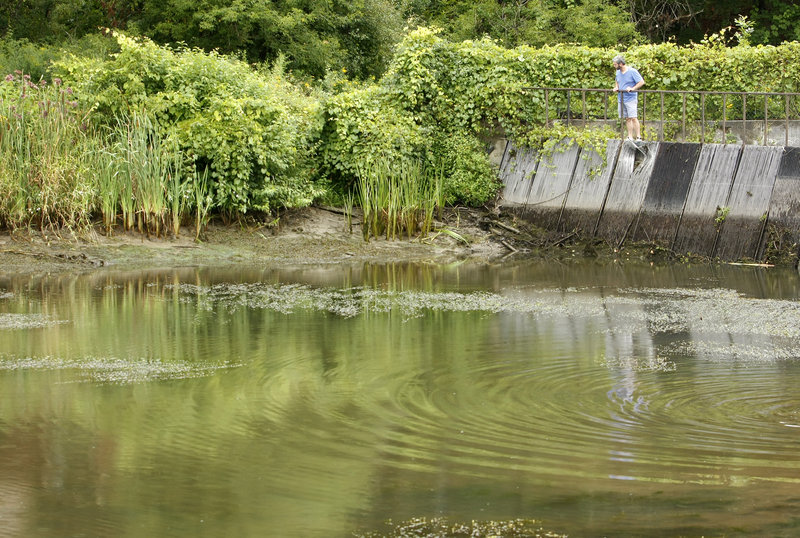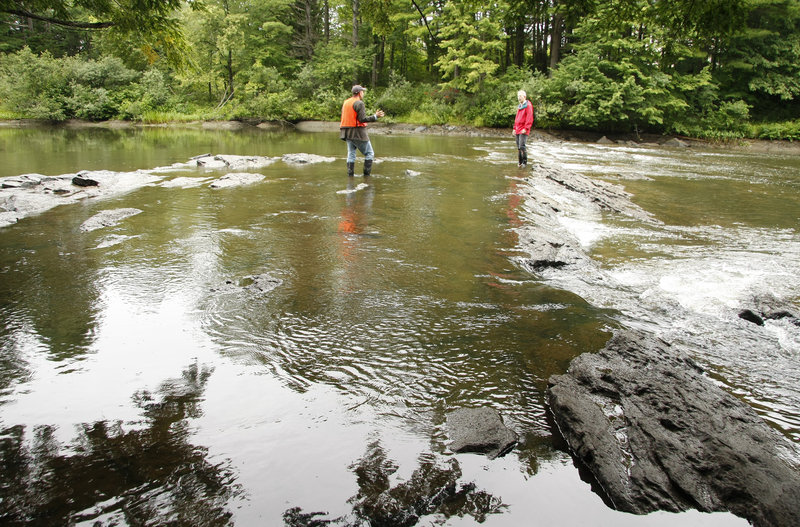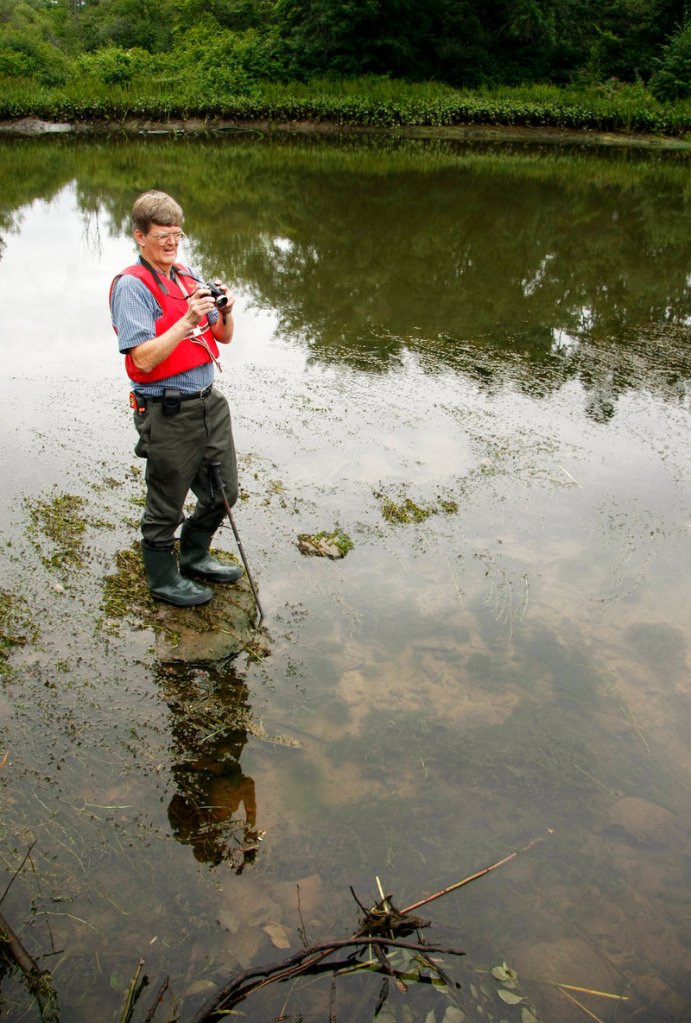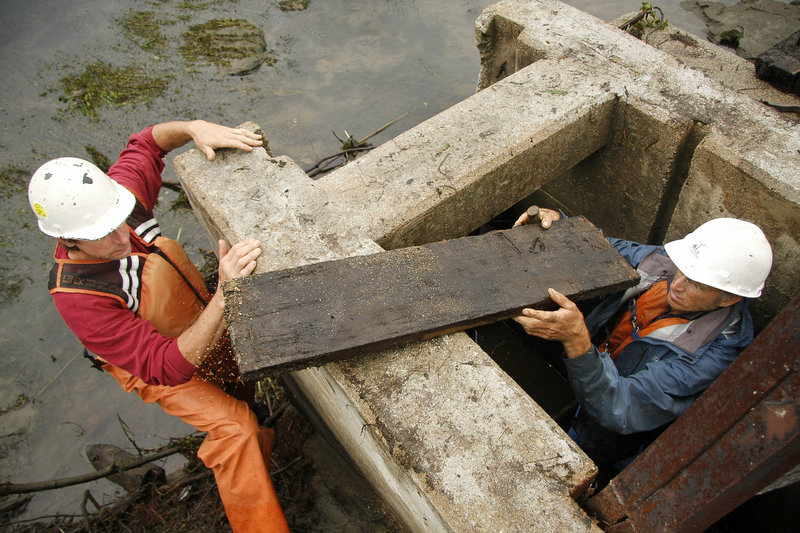YARMOUTH – George Kendrick experienced something near bliss on Monday, standing on an outcropping of ledge in the middle of the Royal River.
“This is very cool,” Kendrick said, beaming with joy. “It shows us what it probably could look like upriver.”
A few hours earlier, the ledge had been submerged beneath the impoundment of water held back by a dam just above Bridge Street. The rock barrier creates a natural pool just above the Beth Condon Memorial Pathway footbridge and allows the river to riffle on its way.
Kendrick, a geologist and environmental consultant who lives in Yarmouth, mapped the river bottom with sonar in 2008 for the town’s Royal River Corridor Master Plan. He knew the ledge was there but, until Monday, had never seen it exposed.
On Monday morning, town officials made good on a promise to draw down the dam’s impoundment for the first time in more than 20 years. They wanted to inspect the aging dam and its abandoned fish ladder. They also wanted to survey and photograph the river at a reduced level.
The goal is to inform an ongoing and potentially controversial community conversation about the possibility of removing two town-owned dams and attracting ocean fish to spawn upriver once again.
Starting at 7:30 a.m., they let the water run full force through one of three turbines in the hydroelectric plant at the Sparhawk Mill. By 9 a.m., workers had fully opened two additional sluiceways, at either end of the dam.
By 10:30 a.m., the water level had dropped as far as possible — about 3 feet in three hours — exposing a rim of muck and the yellow stems of reeds along the river’s banks.
Several people stopped to watch the drawdown, though the results were less than exciting for some.
Town Manager Nat Tupper had to admit, “It’s a little bit of a yawner.”
Town Engineer Dan Jellis said he plans to leave the water level low for the next two days so consulting engineers, residents and others can view the river in that state.
The Royal River has been harnessed since the 1700s, held back by dams to provide power and water access to dozens of mills and factories in the past.
Today, the town owns two dams — one just above Bridge Street and one just below East Elm Street — that it has struggled for years to maintain. Town officials said they would like to inspect the East Elm Street dam, but engineers have found no way to release water from its impoundment.
The Bridge Street dam feeds the hydroelectric plant in the Sparhawk Mill, a former grain-sack factory that now houses several businesses.
When the town made a power-generating agreement with the mill’s owner in the 1980s, the three turbines were expected to generate 900,000 kilowatt hours of electricity annually, Tupper said. The owner was required to give the town 25 percent of the net proceeds from the sale of any electricity that wasn’t used by the mill’s tenants, minus his costs for financing, insurance and taxes.
“It’s never performed to theory and never generated any real revenue for the town,” said Tupper, who estimated that Yarmouth has netted less than $4,000 from the plant’s proceeds since the mid-1980s.
The owner, Bob Poor of Granite Ridge Property Group in Yarmouth, couldn’t be reached for comment Tuesday.
Michael Wilbur, a building contractor who lives in a house beside the dam, said he monitors the dam and takes care of the hydroelectric plant in Poor’s absence. The river, whose sources include Sabbathday Lake, supplies enough water to run one of the three turbines, autumn through spring.
“All winter, we can run one generator pretty much full throttle,” Wilbur said. “In an ideal flow, we can run two.”
Wilbur said he volunteers to operate the plant because “it’s cool. It’s the ultimate green power.” Still, he acknowledged the dam’s environmental impacts, including keeping alewives, eels and shad from making their way upriver to spawn.
“I suppose there are always trade-offs,” Wilbur said. “It’s an interesting conundrum.”
When the town considers the question of removing the dams in the months or years ahead, the debate could get heated, said Landis Hudson, executive director of Maine Rivers, a nonprofit that promotes river preservation and restoration.
Though state environmental agencies encourage reconnecting the ocean with inland waterways, the prospect has divided some communities, including Winslow, where the Fort Halifax Dam on the Sebasticook River was removed in 2008. Since then, the alewife population has returned to the river, assisted by a fish elevator at the Benton Falls Dam upstream, Hudson said.
Peter Maher, who lives a few houses from the Bridge Street Dam, said he would like to see Yarmouth’s dams removed and the river restored to promote fish passage.
“The amount of energy that’s produced here is insignificant and should be ignored in the debate,” Maher said. “The costs to the town are going to increase, and they will eventually decide to remove them anyway.”
Carter Becker, owner of Falls Point Marine in neighboring Freeport, said he thinks Yarmouth should maintain and improve the Bridge Street dam and its fish ladder, possibly with help from volunteers.
The town hired Becker, a marine contractor, to open the dam’s sluiceways and dismantle the ice-damaged iron gate on the fish ladder that the Maine Department of Marine Resources stopped maintaining years ago. He owns a dormant dam at the former Yorktown Paper Mill on Cobbosseecontee Stream in Gardiner, and he would like to revitalize it.
Becker said the sight and sound of water rushing over the Bridge Street dam is beautiful, and its ability to generate electricity should be preserved.
“Let’s work together to move this resource forward,” he said, “instead of infighting about taking it away.”
Staff Writer Kelley Bouchard can be contacted at 791-6328 or at:
kbouchard@pressherald.com
Send questions/comments to the editors.






Success. Please wait for the page to reload. If the page does not reload within 5 seconds, please refresh the page.
Enter your email and password to access comments.
Hi, to comment on stories you must . This profile is in addition to your subscription and website login.
Already have a commenting profile? .
Invalid username/password.
Please check your email to confirm and complete your registration.
Only subscribers are eligible to post comments. Please subscribe or login first for digital access. Here’s why.
Use the form below to reset your password. When you've submitted your account email, we will send an email with a reset code.